Mastering the Art of Wrap Baking: Traditional vs. Naked Japanese Sweet Potatoes
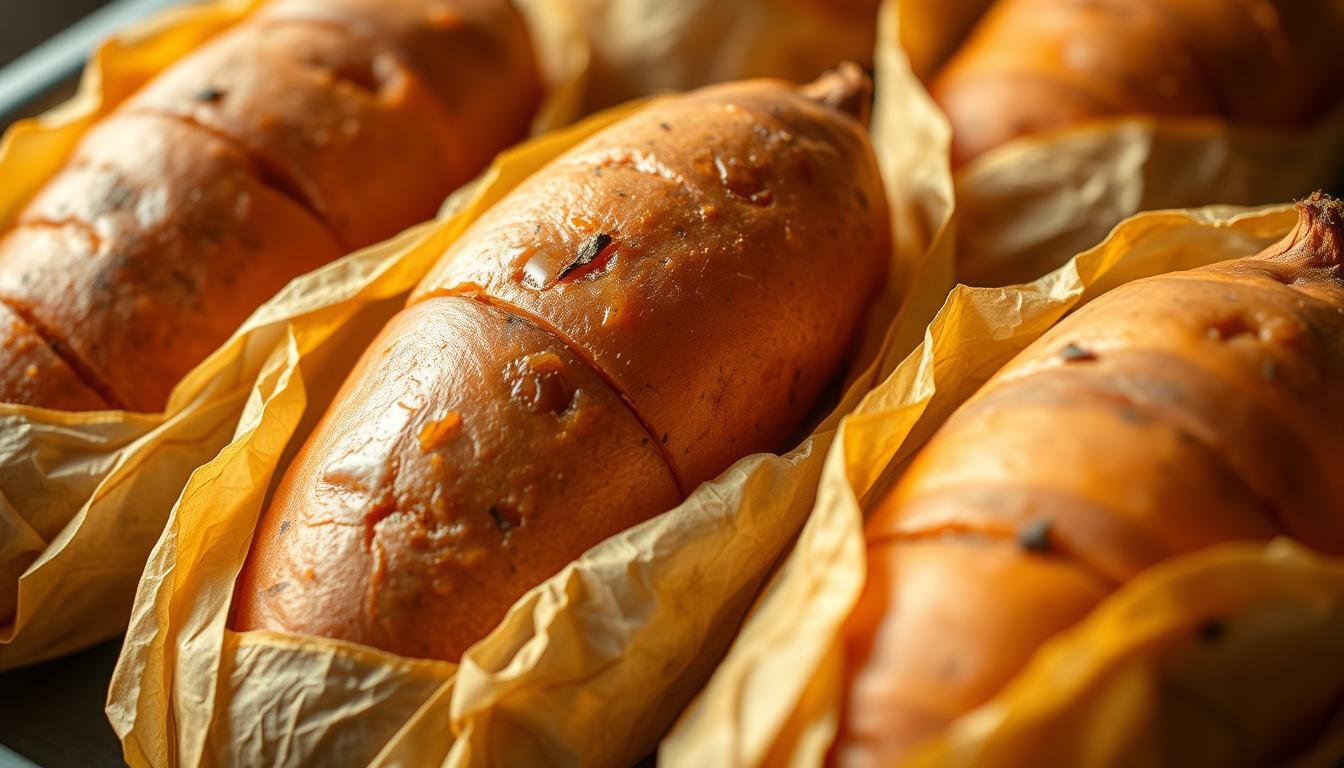
Do you remember the good old Sundays with the smell of sweet potatoes in the air? There’s nothing like the joy of having a warm, oven-baked sweet potato. It’s like a delicious taste of home. Today, let’s explore how Japanese sweet potatoes can be made. We’ll look at the traditional wrap baking method and the modern, unwrapped way. These simple methods turn simple roots into yummy delights.
Discovering traditional wrap baking of Japanese sweet potatoes felt like finding a secret. Each step made the potatoes sweeter and creamier. Trying them without wraps, though, showed me new, crunchy textures and sweet flavors.
Whether you’re just starting to cook or you’re already a kitchen pro, this guide is for you. It will teach you new tricks and add fun to your cooking. So, let’s start and see the differences between wrap baking and naked baking Japanese sweet potatoes!
Key Takeaways
- Wrap baking Japanese sweet potatoes preserves moisture and enhances natural sweetness.
- Naked baking offers a rustic texture with caramelized flavors.
- Both techniques offer unique culinary benefits worth exploring.
- Japanese sweet potatoes are a versatile and nutritious ingredient.
- Experimenting with these methods can add delicious variety to your meals.
Understanding Japanese Sweet Potatoes
Japanese sweet potatoes are a true gem in the kitchen. They grow well in Japan’s warm areas, like Kyushu and Okinawa. If you love cooking or are new to Japanese food, getting to know these sweet potatoes is important. They make many tasty and healthy dishes.
Origins and Varieties
Japanese sweet potatoes have an interesting story. They came to Japan in the 17th century. Now, they are a key food there. You can find different types like Murasaki, Satsumaimo, and Beni Imo. Each one tastes a bit different, which makes cooking fun and enjoyable.
Nutritional Benefits
These sweet potatoes are full of good stuff! They have vitamins A, C, and E to keep you healthy and make your skin look its best. They also have fiber and antioxidants. These help your digestion and protect your body from harm. Adding them to your diet is tasty and good for you.
Flavor Profiles
The taste of Japanese sweet potatoes stands out. They are sweet with a bit of a nutty flavor. Each kind has its own unique taste. Wrap baking them brings out their sweetness even more. It also makes them super soft to eat.
The Wrap Baking Technique Explained
If you want to try easy Japanese recipes, start with wrap baking. This method will make your baking better, with tasty results. Learn to bake sweet potatoes perfectly this way.
Essential Ingredients
First, gather your ingredients. The main one is the sweet potato. Use Japanese ones for their smooth texture and sweetness. You also need something to wrap them in, like parchment paper or aluminum foil. These keep in the moisture and flavor.
Here’s what you’ll need:
| Ingredient | Quantity |
|---|---|
| Japanese Sweet Potatoes | 2-4 medium-sized |
| Parchment Paper or Aluminum Foil | Enough to wrap each potato individually |
| Olive Oil or Butter (optional) | 1-2 tablespoons |
Step-by-Step Instructions
Ready to start? Here are the steps to perfect wrap baking:
- Preheat the oven: Set it to 375°F (190°C) for even baking.
- Prepare the sweet potatoes: Rinse and dry them well.
- Wrap ’em up: Wrap each sweet potato in your chosen material. They should be snug to keep in steam and flavors.
- Bake: Put them on a baking sheet and into the oven. Bake for 45-60 minutes. They’re ready when a fork slides in easily.
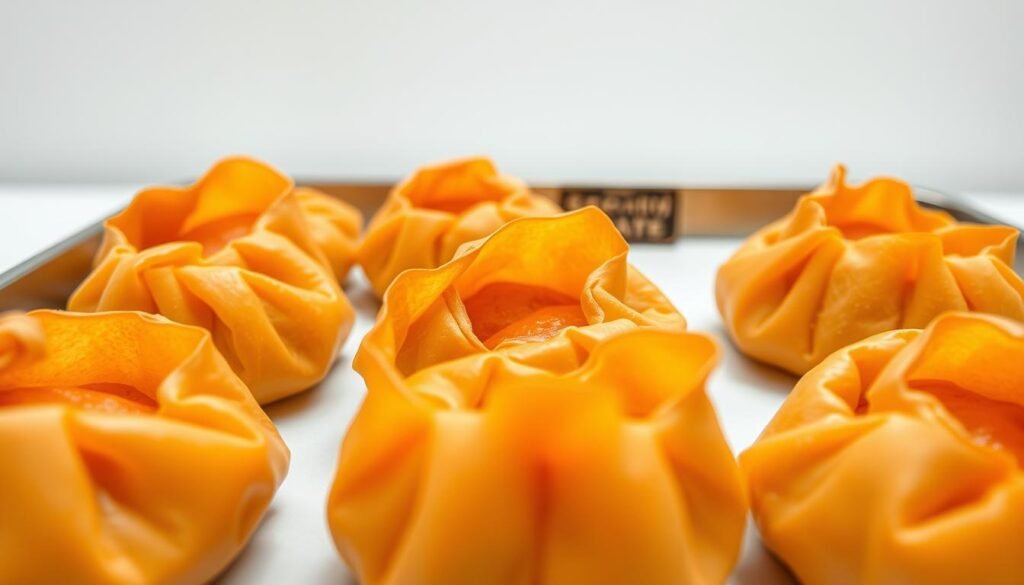
Tips for Perfectly Wrapped Potatoes
For top sweet potato cooking ideas, follow these tips. Your sweet potatoes will be delicious every time:
- Choose uniform sizes: This makes sure they all cook the same.
- Don’t skip the wrap: It’s key for keeping in moisture and flavor. Wrap them tightly.
- Check for doneness: Use a fork to test. If it’s easy, they’re done.
- Add a twist: Brush them with olive oil or butter before wrapping for more flavor.
Using these tips will give you yummy, moist, and flavorful sweet potatoes when you bake.
The Naked Baking Method
Naked baking makes sweet potatoes without wrapping them. Your kitchen will smell amazing as they cook. The skin gets crispy, and the inside caramelizes. This way, flavors pop and prep time drops. But, it’s good to look at the good and bad sides!
What is Naked Baking?
Naked baking means cooking sweet potatoes with nothing on them. It’s great for Japanese sweet potatoes’ taste and texture. I love how it makes the skin crispy but keeps the inside soft and sweet.
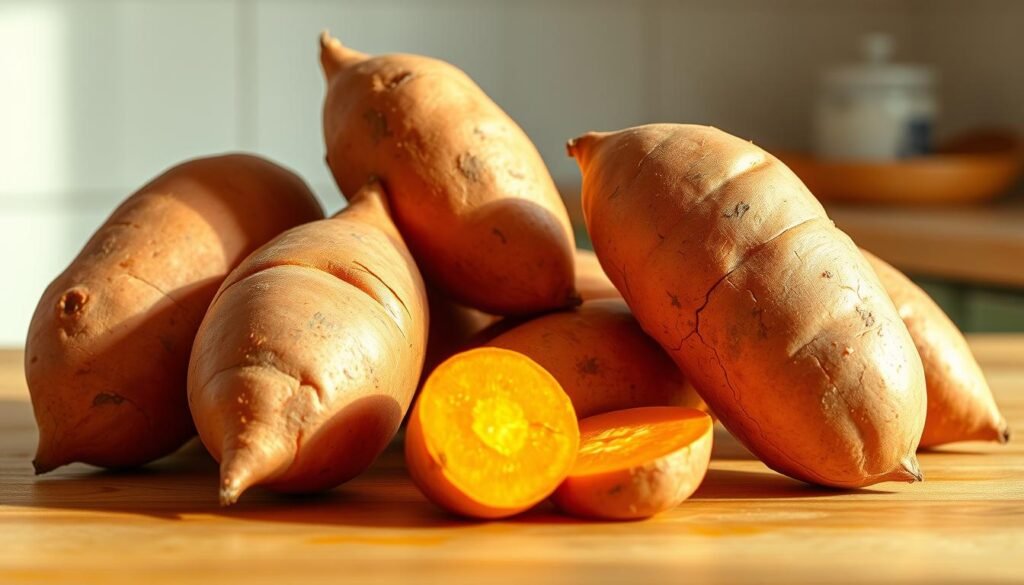
Pros and Cons of Naked Baking
| Pros | Cons |
|---|---|
| Enhanced Flavor | Potential Moisture Loss |
| Reduced Preparation Time | Requires Monitoring |
| Crispy Skin | Possible Dry Edges |
Naked baking boosts flavor and makes skins crispy. But, potatoes might lose some moisture. I remind myself to check them so they don’t dry out. Still, that crispy skin makes it all worth it!
Ideal Cooking Times
The right time is key for perfect naked sweet potatoes. Usually, 45-60 minutes at 375°F is best. But, since ovens and potatoes vary, keep an eye on them. They’re done when the skin is crispy and a fork slides in easily.
Want to try naked baking? It will change the way you cook sweet potatoes! And remember to share how it goes for you!
Comparing Wrap Baking and Naked Baking
Baking sweet potatoes is a fun kitchen adventure! Choose wrap baking or naked baking. Each has unique benefits and tastes. Let’s look at how they differ in flavor, texture, and time.
Flavor Differences
The flavor changes between wrap and naked baking. With a wrap, like Japanese sweet potato wraps, the sweetness stays. The taste is richer but softer. Naked baking makes the flavors stronger and deeper. This can make your dishes stand out.
Texture and Moisture
Texture and moisture vary too. Wrap baking makes sweet potatoes soft, moist, and creamy. They melt in your mouth! Naked baking creates a crispy skin. The inside is a bit drier but still tasty. This influences your cooking choices.
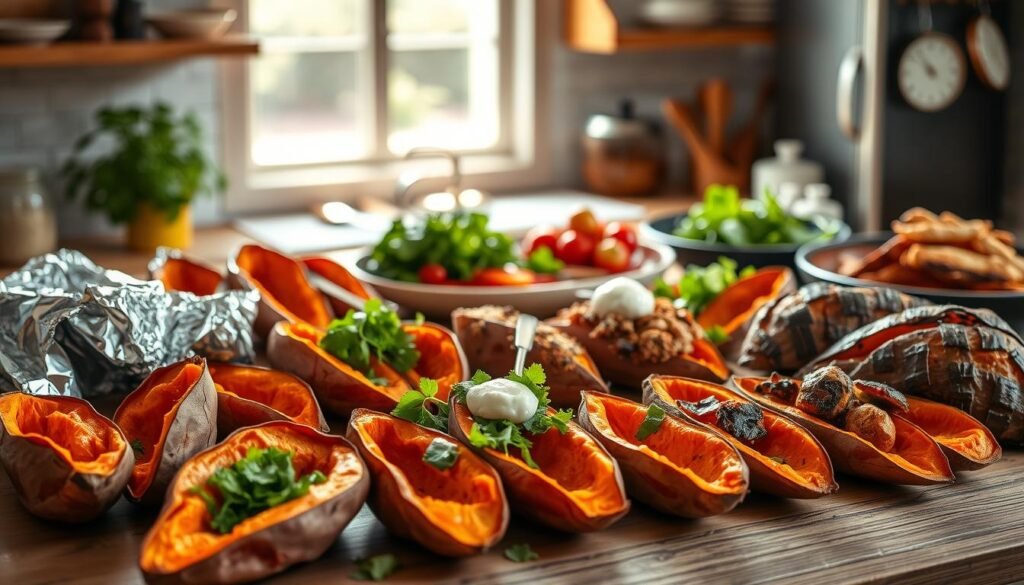
Cooking Times Comparison
Cooking time is important. Wrapped sweet potatoes take longer. The wrap slows cooking. But, the soft texture is worth the wait. Naked baking is faster. It’s because of the direct heat. This makes it a quicker choice for your meals.
| Aspect | Wrap Baking | Naked Baking |
|---|---|---|
| Flavor | More natural, subtle sweetness | Deeper, caramelized flavors |
| Texture | Soft, moist, and creamy | Crispier skin, drier inside |
| Cooking Time | Longer | Shorter |
Tools and Equipment for Baking
Getting the right tools is key for baking perfect Japanese sweet potatoes. If you want to make tasty wraps or simple baked sweet potatoes, the right gear makes it easier to get good results. Here’s what you need to start.
Must-Have Kitchen Tools
First off, a quality oven and air fryer are essential. They let you try lots of sweet potato dishes. A reliable kitchen thermometer is also critical to hit the right cooking temperatures. And for evenly sliced sweet potato wraps, a good mandoline slicer is recommended.
Paper vs. Foil Wraps
The choice between paper and foil wraps matters. Foil traps heat and moisture, speeding up cooking. This method works well for oven-baked sweet potatoes. Paper wraps, though, let a bit more air in. This can make the outside a bit crispier, just right for some recipes!
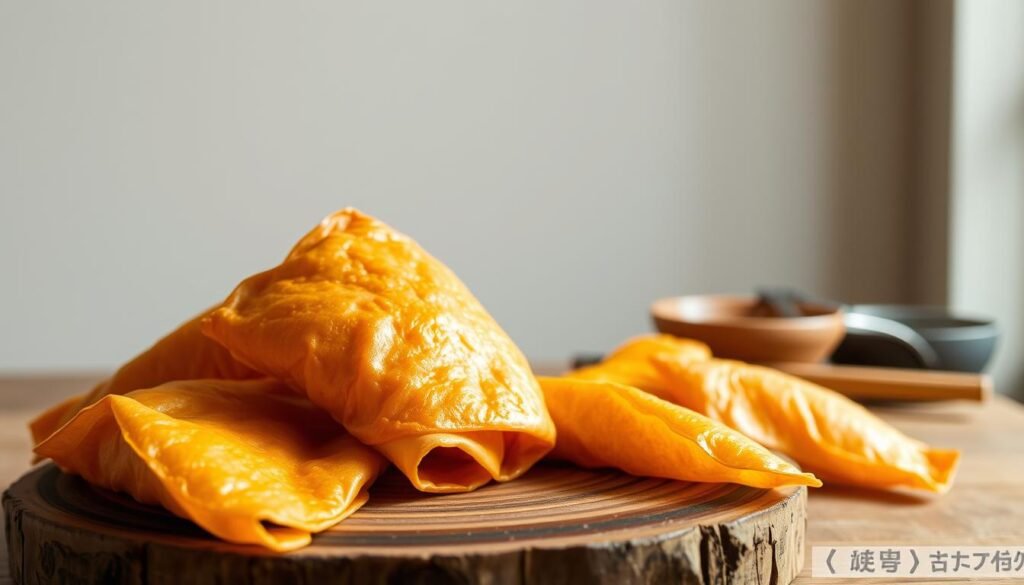
Oven vs. Air Fryer
Choosing between an oven and an air fryer depends on your goals. An oven is great for big batches, fitting lots of sweet potatoes at once. But, an air fryer cooks faster and is better for small amounts. It also makes the outside crispy with less effort.
Using the right tools makes cooking better, giving you perfect Japanese sweet potato wraps. Whether you use an oven or try an air fryer, each method has its perks.
Enhancing Flavor with Seasonings
The right seasonings can change everything for Japanese sweet potatoes. Traditional Japanese seasonings enhance their natural sweetness and add depth. Let’s explore how these can uplift your healthy sweet potato dishes!

Traditional Japanese Seasonings
My top way to boost a sweet potato dish is with miso and wasabi. Miso brings a savory depth that’s hard to resist. In contrast, wasabi adds a spicy kick, making a great combo with sweet potatoes.
Creative Flavor Combinations
Be bold with flavors! Try soy sauce and honey for a sweet-savory glaze. Or add seaweed flakes for salty umami taste. Mixing sesame oil and ginger can give dishes a warm, aromatic taste. These ideas can make simple dishes amazing.
Pairing Suggestions
To make a full, tasty meal, mix your seasoned sweet potatoes with proteins or veggies. Here are some great ideas:
| Protein | Vegetable | Flavor Combination |
|---|---|---|
| Grilled Teriyaki Chicken | Steamed Bok Choy | Soy Sauce + Honey + Scallions |
| Salmon | Sautéed Spinach | Miso + Sesame Seeds + Shredded Nori |
| Tofu | Roasted Red Peppers | Wasabi + Ginger + Garlic |
Using these seasonings with sweet potatoes makes dishes nutritious and tasty. Try these ideas and enjoy Japan’s flavors at your table!
Serving Suggestions for Japanese Sweet Potatoes
Japanese sweet potatoes are a versatile delight. They can make ordinary meals special! Let’s dive into some great sides, creative ideas, and tasty recipes for everyone.
Popular Accompaniments
Adding simple sides to Japanese sweet potatoes can make any dish better. Try them with roasted veggies like bell peppers and zucchini. Add sesame oil for an Asian taste. Or, pair them with grilled chicken or fish for a hearty meal.
Presentation Ideas
Make your dish a visual treat! Fill Japanese sweet potato wraps with radishes, avocado, and ginger. Sprinkle black sesame seeds on top for a great look. Also, try serving them on a ceramic platter, topped with herbs like cilantro.
Creative Recipes
Want to try something new? Use these recipes to highlight sweet potatoes in exciting ways.
| Recipe | Ingredients | Instructions |
|---|---|---|
| Sweet Potato Sushi Rolls | Japanese sweet potatoes, sushi rice, nori sheets, avocado, cucumber | Roast sweet potatoes, slice thinly, and roll with sushi rice, nori, avocado, and cucumber. Serve with soy sauce and wasabi. |
| Miso Glazed Sweet Potatoes | Japanese sweet potatoes, miso paste, mirin, soy sauce, sesame seeds | Brush sliced sweet potatoes with miso glaze made from miso paste, mirin, and soy sauce. Roast until caramelized, then sprinkle with sesame seeds. |
| Sweet Potato Tempura | Japanese sweet potatoes, tempura batter mix, oil for frying, tempura dipping sauce | Coat sweet potato slices in tempura batter and fry until golden. Serve with a dipping sauce made from soy sauce, mirin, and dashi. |
Troubleshooting Common Baking Issues
Baking sweet potatoes can be tricky. We’ve all bumped into problems now and then. I’m here to guide you through common issues with Japanese sweet potatoes. We’ll tackle undercooked insides to overdone skins. Let’s learn to nail your sweet potato dishes.
Undercooked Sweet Potatoes
Ever cut into a Japanese sweet potato and it’s hard inside? It’s annoying, isn’t it? One trick is to pick potatoes of the same size. This helps them cook evenly. Also, make sure your oven is hot before you start. And keep the temperature steady. Poke them with a fork to see if they’re ready. They should feel soft all the way through.
Dry or Overcooked Results
A dry sweet potato is not enjoyable. To avoid this, you might need to lower your oven’s heat. A little water can also make a big difference. Wrapping the potatoes in foil keeps them moist. This trick makes your sweet potatoes tasty and healthy. Also, don’t put too many potatoes close together on the tray. They need space for air to flow around them.
Troubles with Even Baking
Uneven baking is a common mistake. It helps to place potatoes in the middle of the oven. This way, they get consistent heat. Using an air fryer? Make sure to turn them over halfway. These tips can make a big difference. Keep practicing, and soon you’ll be great at baking Japanese sweet potatoes.
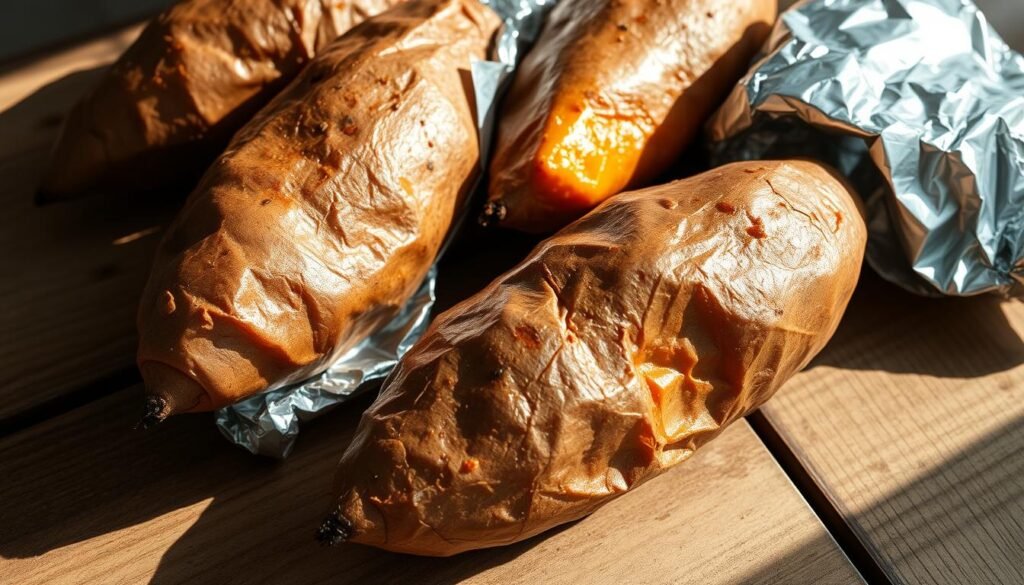
Conclusion: Choosing Your Baking Method
So, we looked at two ways to bake Japanese sweet potatoes. You can wrap them or bake them naked. Each style makes the potatoes taste special. It depends on what you want from your sweet potato recipe.
When to Wrap and When to Go Naked
Want a soft, juicy bite? Try wrapping your sweet potatoes. This keeps them moist. But if you like a bit crispy and sweet, bake them without a wrap. This makes the skin crispy and tasty.
Final Thoughts on Japanese Sweet Potatoes
Choose any method, you’re stepping into the world of Japanese sweet potatoes. They are full of nutrients and flavors. Try different ways to cook them to delight your family’s taste buds.
Encouraging Experimentation in the Kitchen
Playing in the kitchen is fun! Learning these baking styles is exciting. Mix it up with different spices or side dishes. Explore all the sweet potato recipes you can imagine. And enjoy every bite of these amazing Japanese sweet potatoes!
